Attractions · Europe · Going Out · Greece · Regions · Western Europe
5 places to visit in Crete to discover Greek mythology
Greek mythology is a body of famous stories of gods, heroes and mythical beasts. Although there is a considerable element of fiction, the myths they have inspired have continued to influence the art and literature we recognise today. For those with an interest in Greek mythology or simply a love of historical sites a visit to Crete is not complete without a visit to these 5 ancient sites.
1. Archaeological site of Knossos
A must-see sight in Crete, Knossos has been named Europes oldest city and is the largest site in Crete. Steeped in fascinating stories of Greek myths, Knossos is a site to behold. The ruins are believed to have been the home to King Minos and the mythical Minotaur who was held in the citys labyrinth. This impressive historical site holds ruins of great palaces and ancient architecture. The partially rebuilt ruins paint a vivid picture of life in early settlements and ancient civilisation.
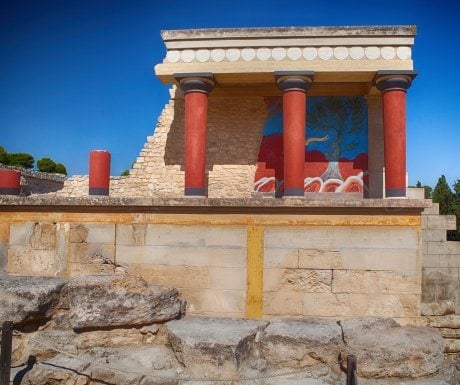 Knossos plays a heavy part in Greek mythology. The city’s famous labyrinth was designed by Daedalus to contain the mythical Minotaur. The Minotaur was the monstrous child of the kings wife and a white bull gifted to Minos by Poseidon. Trapped in the labyrinth by Minos, Daedalus invented wings for him and his son Icarus to escape. In the famous story his foolish son flew too close to the sun and his wings melted off. There is also the story of Theseus, son of Aegean, who eventually defeated the Minotaur. The daughter of Minos, Ariadne had fallen in love with Theseus and gave him a ball of thread so he could escape the maze.
2. The birthplace of Zeus
According to myth, Greek god Zeus was born in Crete. There are two caves in Crete, Ideon and Dikteon which both claim the honour. The Dikteon cave is notably more focused on visitors; located in the Lasithi Plateau in eastern Crete the caves are well worth a visit. The caves are adorned with impressive stalagmites and stalactites and five well-lit chambers. Discover the haunting remains of religious offerings at the historical altar. This beautiful cave is rich in animal life and a glistening lake in its lowest cavern.
Knossos plays a heavy part in Greek mythology. The city’s famous labyrinth was designed by Daedalus to contain the mythical Minotaur. The Minotaur was the monstrous child of the kings wife and a white bull gifted to Minos by Poseidon. Trapped in the labyrinth by Minos, Daedalus invented wings for him and his son Icarus to escape. In the famous story his foolish son flew too close to the sun and his wings melted off. There is also the story of Theseus, son of Aegean, who eventually defeated the Minotaur. The daughter of Minos, Ariadne had fallen in love with Theseus and gave him a ball of thread so he could escape the maze.
2. The birthplace of Zeus
According to myth, Greek god Zeus was born in Crete. There are two caves in Crete, Ideon and Dikteon which both claim the honour. The Dikteon cave is notably more focused on visitors; located in the Lasithi Plateau in eastern Crete the caves are well worth a visit. The caves are adorned with impressive stalagmites and stalactites and five well-lit chambers. Discover the haunting remains of religious offerings at the historical altar. This beautiful cave is rich in animal life and a glistening lake in its lowest cavern.
 In Greek mythology Titan Cronus was fearful that his children would overthrow him. To prevent this occurrence he ate all his children. His wife titan Rhea hid infant Zeus in a cave in Crete. Legend says she tricked Cronus by feeding him a stone wrapped in cloth.
3. Ancient Aptera
The ancient ruins of Aptera are just three kilometres east of Chania. A somewhat historical puzzle, the remains of an ancient temple and roman cisterns are still being uncovered today. Once a powerful city in Minoan Crete the city was destroyed by an earthquake in the 7th century AD. Learn about the history of an ancient city with a guided tour or simply admire the ancient walls of the remaining landmark. Best take your camera as Aptera enjoys panoramic views of glistening Souda Bay and Akrotiri to the north and jaw dropping mountains to the south.
In Greek mythology Titan Cronus was fearful that his children would overthrow him. To prevent this occurrence he ate all his children. His wife titan Rhea hid infant Zeus in a cave in Crete. Legend says she tricked Cronus by feeding him a stone wrapped in cloth.
3. Ancient Aptera
The ancient ruins of Aptera are just three kilometres east of Chania. A somewhat historical puzzle, the remains of an ancient temple and roman cisterns are still being uncovered today. Once a powerful city in Minoan Crete the city was destroyed by an earthquake in the 7th century AD. Learn about the history of an ancient city with a guided tour or simply admire the ancient walls of the remaining landmark. Best take your camera as Aptera enjoys panoramic views of glistening Souda Bay and Akrotiri to the north and jaw dropping mountains to the south.
 In mythology goddess Hera convinced the Sirens (half women half bird creatures who lured sailors to death with enchanting singing) to compete in a singing contest with the Muses (inspirational goddesses of literature and knowledge). After the Sirens lost the Muses plucked out their feathers and the Sirens cast themselves in to the sea. The term Aptera translates to wingless.
4. Phaistos Minoan Palace
Phaistos was known as the second largest city in Minoan Crete. Located upon a hilltop, the archaeological site enjoys beautiful views of the Messara plain in central Crete. A truly remarkable experience in Greek history, there is a collection of detailed artefacts and fascinating ancient walls. A slightly simpler version of Knossos, Phaistos shares some of its appearance but on further examination there is a complexity in its architectural elements.
In mythology goddess Hera convinced the Sirens (half women half bird creatures who lured sailors to death with enchanting singing) to compete in a singing contest with the Muses (inspirational goddesses of literature and knowledge). After the Sirens lost the Muses plucked out their feathers and the Sirens cast themselves in to the sea. The term Aptera translates to wingless.
4. Phaistos Minoan Palace
Phaistos was known as the second largest city in Minoan Crete. Located upon a hilltop, the archaeological site enjoys beautiful views of the Messara plain in central Crete. A truly remarkable experience in Greek history, there is a collection of detailed artefacts and fascinating ancient walls. A slightly simpler version of Knossos, Phaistos shares some of its appearance but on further examination there is a complexity in its architectural elements.
 Phaistos is one of three towns in Minoan Crete ruled by the children of Zeus and Europa. Phaistos was ruled by King Rhadamanthus who was later driven out of Crete by his brother Minos. In Greek mythology Rhadamanthus was later depicted as one of the judges of the dead.
5. Gortyn & the plane tree of Zeus
At the archaeological site of Gortyn there is far more than meets the eye. This quiet and unassuming site located south of Heraklion is still being excavated today. Uncover the ruins of an ancient theatre, the church of St Titus and the famous Plane Tree. Step away from the main sites and just across the road more fascinating ruins lay ready for exploration.
Phaistos is one of three towns in Minoan Crete ruled by the children of Zeus and Europa. Phaistos was ruled by King Rhadamanthus who was later driven out of Crete by his brother Minos. In Greek mythology Rhadamanthus was later depicted as one of the judges of the dead.
5. Gortyn & the plane tree of Zeus
At the archaeological site of Gortyn there is far more than meets the eye. This quiet and unassuming site located south of Heraklion is still being excavated today. Uncover the ruins of an ancient theatre, the church of St Titus and the famous Plane Tree. Step away from the main sites and just across the road more fascinating ruins lay ready for exploration.
 According to myth, Zeus disguised as a bull abducted Princess Europa from Lebanon (the origin of the name Europe is said to come from this princess). Their affair took place under a tree now known as Plane Tree. From the affair, three children were born, Minos, Rhadamanthus and Sarpedon who became famous kings of Minoan palaces in Crete.
Nick Munday is Managing Director at Classic Collection Holidays.
If you would like to be a guest blogger on A Luxury Travel Blog in order to raise your profile, please contact us.
According to myth, Zeus disguised as a bull abducted Princess Europa from Lebanon (the origin of the name Europe is said to come from this princess). Their affair took place under a tree now known as Plane Tree. From the affair, three children were born, Minos, Rhadamanthus and Sarpedon who became famous kings of Minoan palaces in Crete.
Nick Munday is Managing Director at Classic Collection Holidays.
If you would like to be a guest blogger on A Luxury Travel Blog in order to raise your profile, please contact us.
 Knossos plays a heavy part in Greek mythology. The city’s famous labyrinth was designed by Daedalus to contain the mythical Minotaur. The Minotaur was the monstrous child of the kings wife and a white bull gifted to Minos by Poseidon. Trapped in the labyrinth by Minos, Daedalus invented wings for him and his son Icarus to escape. In the famous story his foolish son flew too close to the sun and his wings melted off. There is also the story of Theseus, son of Aegean, who eventually defeated the Minotaur. The daughter of Minos, Ariadne had fallen in love with Theseus and gave him a ball of thread so he could escape the maze.
2. The birthplace of Zeus
According to myth, Greek god Zeus was born in Crete. There are two caves in Crete, Ideon and Dikteon which both claim the honour. The Dikteon cave is notably more focused on visitors; located in the Lasithi Plateau in eastern Crete the caves are well worth a visit. The caves are adorned with impressive stalagmites and stalactites and five well-lit chambers. Discover the haunting remains of religious offerings at the historical altar. This beautiful cave is rich in animal life and a glistening lake in its lowest cavern.
Knossos plays a heavy part in Greek mythology. The city’s famous labyrinth was designed by Daedalus to contain the mythical Minotaur. The Minotaur was the monstrous child of the kings wife and a white bull gifted to Minos by Poseidon. Trapped in the labyrinth by Minos, Daedalus invented wings for him and his son Icarus to escape. In the famous story his foolish son flew too close to the sun and his wings melted off. There is also the story of Theseus, son of Aegean, who eventually defeated the Minotaur. The daughter of Minos, Ariadne had fallen in love with Theseus and gave him a ball of thread so he could escape the maze.
2. The birthplace of Zeus
According to myth, Greek god Zeus was born in Crete. There are two caves in Crete, Ideon and Dikteon which both claim the honour. The Dikteon cave is notably more focused on visitors; located in the Lasithi Plateau in eastern Crete the caves are well worth a visit. The caves are adorned with impressive stalagmites and stalactites and five well-lit chambers. Discover the haunting remains of religious offerings at the historical altar. This beautiful cave is rich in animal life and a glistening lake in its lowest cavern.
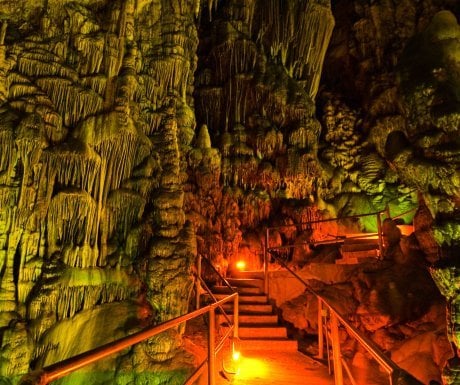 In Greek mythology Titan Cronus was fearful that his children would overthrow him. To prevent this occurrence he ate all his children. His wife titan Rhea hid infant Zeus in a cave in Crete. Legend says she tricked Cronus by feeding him a stone wrapped in cloth.
3. Ancient Aptera
The ancient ruins of Aptera are just three kilometres east of Chania. A somewhat historical puzzle, the remains of an ancient temple and roman cisterns are still being uncovered today. Once a powerful city in Minoan Crete the city was destroyed by an earthquake in the 7th century AD. Learn about the history of an ancient city with a guided tour or simply admire the ancient walls of the remaining landmark. Best take your camera as Aptera enjoys panoramic views of glistening Souda Bay and Akrotiri to the north and jaw dropping mountains to the south.
In Greek mythology Titan Cronus was fearful that his children would overthrow him. To prevent this occurrence he ate all his children. His wife titan Rhea hid infant Zeus in a cave in Crete. Legend says she tricked Cronus by feeding him a stone wrapped in cloth.
3. Ancient Aptera
The ancient ruins of Aptera are just three kilometres east of Chania. A somewhat historical puzzle, the remains of an ancient temple and roman cisterns are still being uncovered today. Once a powerful city in Minoan Crete the city was destroyed by an earthquake in the 7th century AD. Learn about the history of an ancient city with a guided tour or simply admire the ancient walls of the remaining landmark. Best take your camera as Aptera enjoys panoramic views of glistening Souda Bay and Akrotiri to the north and jaw dropping mountains to the south.
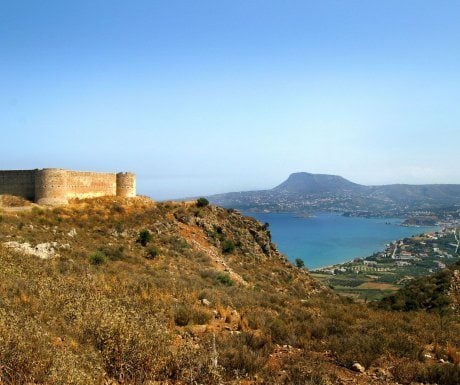 In mythology goddess Hera convinced the Sirens (half women half bird creatures who lured sailors to death with enchanting singing) to compete in a singing contest with the Muses (inspirational goddesses of literature and knowledge). After the Sirens lost the Muses plucked out their feathers and the Sirens cast themselves in to the sea. The term Aptera translates to wingless.
4. Phaistos Minoan Palace
Phaistos was known as the second largest city in Minoan Crete. Located upon a hilltop, the archaeological site enjoys beautiful views of the Messara plain in central Crete. A truly remarkable experience in Greek history, there is a collection of detailed artefacts and fascinating ancient walls. A slightly simpler version of Knossos, Phaistos shares some of its appearance but on further examination there is a complexity in its architectural elements.
In mythology goddess Hera convinced the Sirens (half women half bird creatures who lured sailors to death with enchanting singing) to compete in a singing contest with the Muses (inspirational goddesses of literature and knowledge). After the Sirens lost the Muses plucked out their feathers and the Sirens cast themselves in to the sea. The term Aptera translates to wingless.
4. Phaistos Minoan Palace
Phaistos was known as the second largest city in Minoan Crete. Located upon a hilltop, the archaeological site enjoys beautiful views of the Messara plain in central Crete. A truly remarkable experience in Greek history, there is a collection of detailed artefacts and fascinating ancient walls. A slightly simpler version of Knossos, Phaistos shares some of its appearance but on further examination there is a complexity in its architectural elements.
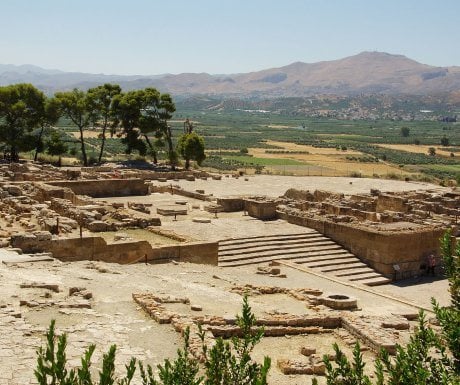 Phaistos is one of three towns in Minoan Crete ruled by the children of Zeus and Europa. Phaistos was ruled by King Rhadamanthus who was later driven out of Crete by his brother Minos. In Greek mythology Rhadamanthus was later depicted as one of the judges of the dead.
5. Gortyn & the plane tree of Zeus
At the archaeological site of Gortyn there is far more than meets the eye. This quiet and unassuming site located south of Heraklion is still being excavated today. Uncover the ruins of an ancient theatre, the church of St Titus and the famous Plane Tree. Step away from the main sites and just across the road more fascinating ruins lay ready for exploration.
Phaistos is one of three towns in Minoan Crete ruled by the children of Zeus and Europa. Phaistos was ruled by King Rhadamanthus who was later driven out of Crete by his brother Minos. In Greek mythology Rhadamanthus was later depicted as one of the judges of the dead.
5. Gortyn & the plane tree of Zeus
At the archaeological site of Gortyn there is far more than meets the eye. This quiet and unassuming site located south of Heraklion is still being excavated today. Uncover the ruins of an ancient theatre, the church of St Titus and the famous Plane Tree. Step away from the main sites and just across the road more fascinating ruins lay ready for exploration.
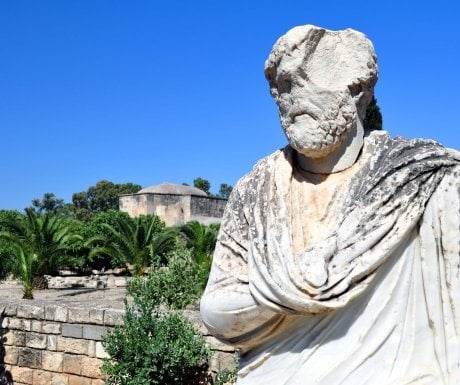 According to myth, Zeus disguised as a bull abducted Princess Europa from Lebanon (the origin of the name Europe is said to come from this princess). Their affair took place under a tree now known as Plane Tree. From the affair, three children were born, Minos, Rhadamanthus and Sarpedon who became famous kings of Minoan palaces in Crete.
Nick Munday is Managing Director at Classic Collection Holidays.
If you would like to be a guest blogger on A Luxury Travel Blog in order to raise your profile, please contact us.
According to myth, Zeus disguised as a bull abducted Princess Europa from Lebanon (the origin of the name Europe is said to come from this princess). Their affair took place under a tree now known as Plane Tree. From the affair, three children were born, Minos, Rhadamanthus and Sarpedon who became famous kings of Minoan palaces in Crete.
Nick Munday is Managing Director at Classic Collection Holidays.
If you would like to be a guest blogger on A Luxury Travel Blog in order to raise your profile, please contact us.Did you enjoy this article?
Receive similar content direct to your inbox.


All of these places are stunning. Visiting sites with history is always so magical to me, especially mythology – it’s like adult fairy tales!! The birthplace of Zeus sounds incredible, and the stalagmites (paired with that red lighting) looks almost spooky to me.
Crete is heaven on earth! Knossos of course is the most important centre of the Minoan civilization and the home of the myth of the Minotaur.